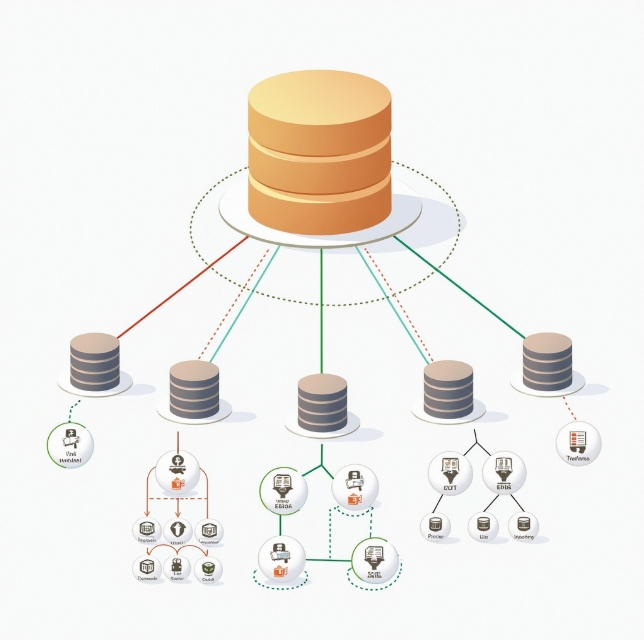How to Build a Single-User E-commerce Platform from Scratch: Efficient Technical Architecture and Development Strategies
- latest articles
- 1.DApp Development & Customization: Merging Diverse Market Needs with User Experience 2.Analysis of the Core Technical System in DApp Project Development 3.How to achieve cross-chain interoperability in Web3 projects? 4.How does the tokenization of points reconstruct the e-commerce ecosystem? 5.How to Set and Track Data Metrics for a Points Mall? 6.What is DApp Development? Core Concepts and Technical Analysis 7.Inventory of commonly used Web3 development tools and usage tips 8.Development of a Distribution System Integrated with Social E-commerce 9.Six Key Steps for Businesses to Build a Points Mall System 10.What is DApp Development? A Comprehensive Guide from Concept to Implementation
- Popular Articles
- 1.Future Trends and Technology Predictions for APP Development in 2025 2.Analysis of the DeFi Ecosystem: How Developers Can Participate in Decentralized Finance Innovation 3.From Zero to One: How PI Mall Revolutionizes the Traditional E-commerce Model 4.DAPP Development | Best Practices for Professional Customization and Rapid Launch 5.Recommended by the Web3 developer community: the most noteworthy forums and resources 6.From Cloud Computing to Computing Power Leasing: Building a Flexible and Scalable Computing Resource Platform 7.Shared Bike System APP: The Convenient Choice in the Era of Smart Travel 8.How to Develop a Successful Douyin Mini Program: Technical Architecture and Best Practices 9.How to Create a Successful Dating App: From Needs Analysis to User Experience Design 10.From Design to Development: The Complete Process of Bringing an APP Idea to Life
In the wave of digital transformation, an increasing number of enterprises and entrepreneurs are choosing to enter the online market by building their own e-commerce platforms. Among these platforms, the Single-user E-commerce Platform is an important form, especially suitable for individuals or small businesses wishing to establish personalized, exclusive e-commerce websites. Unlike multi-user marketplaces, single-user platforms focus on the relationship between one merchant and their consumers, aiming to provide a simple, efficient, and intuitive shopping experience. This article details how to build a single-user e-commerce platform from scratch, including technical architecture design, development strategies, and practical implementation processes.
I. What is a Single-User E-commerce Platform?
1.1 Definition and Characteristics
A single-user e-commerce platform typically refers to an independent platform where a single merchant (or brand) offers products and services, and consumers shop directly on that platform. This type of platform primarily serves a single merchant or individual user, facilitating direct transactions between the merchant and consumers. Unlike traditional large e-commerce platforms (such as Taobao, JD.com, etc.), single-user platforms have the following characteristics:
Simple Business Model: The merchant usually manages all processes, including products, orders, and payments.
High Customizability: Merchants can personalize the platform based on brand image, market demands, and user feedback.
Low Operational Costs: Compared to multi-merchant platforms, operations are simplified, reducing the need for multi-party coordination and system complexity.

1.2 Application Scenarios
Single-user e-commerce platforms are particularly suitable for the following scenarios:
Personalized Brand Promotion: Such as designer brands, handicraft merchants, etc., who wish to showcase their unique brand image through their own platform.
Small Businesses or Independent Merchants: These merchants often lack the resources to join large-scale e-commerce platforms but desire their own e-commerce website.
Independent Product Sales: Some merchants prefer to sell specific products directly without relying on other e-commerce platforms.
II. Technical Architecture of a Single-User E-commerce Platform
2.1 Core Technology Stack Selection
Choosing the right technology stack is crucial when building a single-user e-commerce platform. An efficient and scalable technical architecture ensures the system maintains high availability, maintainability, and performance as it grows. Common technology stacks include:
Frontend Technologies:
HTML/CSS/JavaScript: Used to build the basic page structure and styling of the platform.
React.js/Angular/Vue.js: These modern frontend frameworks help developers efficiently build responsive, dynamically updated user interfaces.
Bootstrap or Tailwind CSS: These frontend frameworks provide support for rapid development and flexible layouts.
Backend Technologies:
Node.js: With its event-driven, non-blocking I/O model, Node.js efficiently handles high-concurrency requests, making it suitable for e-commerce platforms.
Python (Django/Flask): Python is a powerful and easy-to-learn language, ideal for rapid development, and the Django framework is particularly well-suited for e-commerce applications.
PHP (Laravel): PHP remains one of the most widely used languages in e-commerce platform development, with the Laravel framework offering efficient routing and database management features.
Database Technologies:
MySQL or PostgreSQL: These relational databases handle structured data well, supporting complex queries and transaction operations.
MongoDB: If the platform's data structure is more flexible, using a NoSQL database like MongoDB can be advantageous.
Cloud Services and Deployment:
AWS, Azure, Google Cloud: These cloud service platforms provide highly available servers and storage services, enabling the platform to scale elastically.
Docker and Kubernetes: Containerized deployment allows developers to manage and scale the platform application more flexibly.
2.2 System Architecture Design
The system architecture of a single-user e-commerce platform needs to be simple yet efficient, ensuring smooth operation under high concurrency. A typical architecture includes:
Frontend Layer: Responsible for displaying the user interface, including product展示, user registration/login, shopping cart, order checkout, etc.
Business Logic Layer: Handles the core business logic, such as product management, order management, payment gateway integration, user management, etc.
Data Layer: Stores core data like products, users, and orders, ensuring efficient querying and operational performance.
API Layer: Implements frontend-backend separation via APIs, supporting integration with mobile apps or other third-party systems.
2.3 High Availability and High Concurrency Handling
E-commerce platforms must handle high concurrent access and transaction requests. Therefore, the technical architecture must be designed for high availability.
Load Balancing: Distributes requests across multiple servers via a load balancer to ensure high availability and concurrent processing capability.
Caching Mechanisms: Utilize caching tools like Redis or Memcached to reduce database query pressure and speed up response times.
Database Optimization: Improve database read/write performance through techniques like database sharding, partitioning, and index optimization.
III. Development Strategy and Implementation
3.1 User Experience Optimization
In a single-user e-commerce platform, user experience is paramount. Merchants should focus on the following aspects to enhance it:
Simple and Intuitive Interface: The platform's UI design should be clean and clear, avoiding overly complex operations to ensure users can quickly find the products they need.
Responsive Design: The platform must support access from multiple devices, including PCs, mobile phones, and tablets. Using responsive design ensures good display performance across different devices.
Fast Loading Times: Optimize website loading speed by compressing images, using CDN acceleration, etc., to improve page load times.

3.2 Payment and Logistics System Integration
Payment and logistics are critical components of an e-commerce platform. Integration with third-party payment platforms (such as Alipay, WeChat Pay, PayPal, etc.) is necessary to ensure secure and convenient transactions.
Payment Integration: Choose suitable payment gateways that support multiple payment methods to ensure users can complete payments easily.
Logistics Interfaces: Integrate with logistics companies (such as SF Express, YTO Express, JD Logistics, etc.) to provide real-time logistics updates and order tracking features.
3.3 Data Security and Privacy Protection
The platform must implement effective measures to protect users' personal information and transaction data, preventing data breaches or security attacks. Common security measures include:
SSL Encryption: All transmitted data should be encrypted via SSL to prevent interception during network transmission.
Authentication and Authorization: Implement strong authentication mechanisms, such as Multi-Factor Authentication (MFA), to ensure user account security.
Data Backup and Recovery: Regularly back up data and ensure quick recovery in case of system failure.
IV. Marketing and Promotion Strategies
Even with a perfectly designed technical architecture, merchants need effective marketing strategies to attract consumers. Common promotion methods include:
SEO Optimization: Improve the platform's search engine ranking by optimizing keywords, titles, descriptions, etc., on product pages to attract more organic traffic.
Social Media Marketing: Promote the brand through social platforms like WeChat, Weibo, Douyin, etc., to attract user attention and sharing.
Discounts and Promotions: Stimulate purchase desire by offering coupons, limited-time discounts, and other promotional activities.
V. Conclusion
Building a successful single-user e-commerce platform is not only a technical challenge but also requires merchants to have flexible market strategies and excellent user experience design. From frontend development to backend architecture, from payment integration to security assurance, every aspect requires careful refinement and optimization. By following the technical architecture, development strategies, and implementation steps outlined in this article, merchants can establish a solid foundation for their e-commerce platform and lay the groundwork for future success.
Whether starting from scratch or optimizing an existing platform, building an efficient, stable, and user-friendly single-user e-commerce platform requires continuous innovation and practice from developers to ensure the platform stands out in a highly competitive market.
-

How does the tokenization of points reconstruct the e-commerce ecosystem?
With the continuous advancement of internet technology and the gradual prolifera···
-

How to Set and Track Data Metrics for a Points Mall?
With the rapid development of the e-commerce industry, points malls, as a common···
-

Development of a Distribution System Integrated with Social E-commerce
With the rapid development of internet technology, the e-commerce industry has e···

 Blockchain
Blockchain










